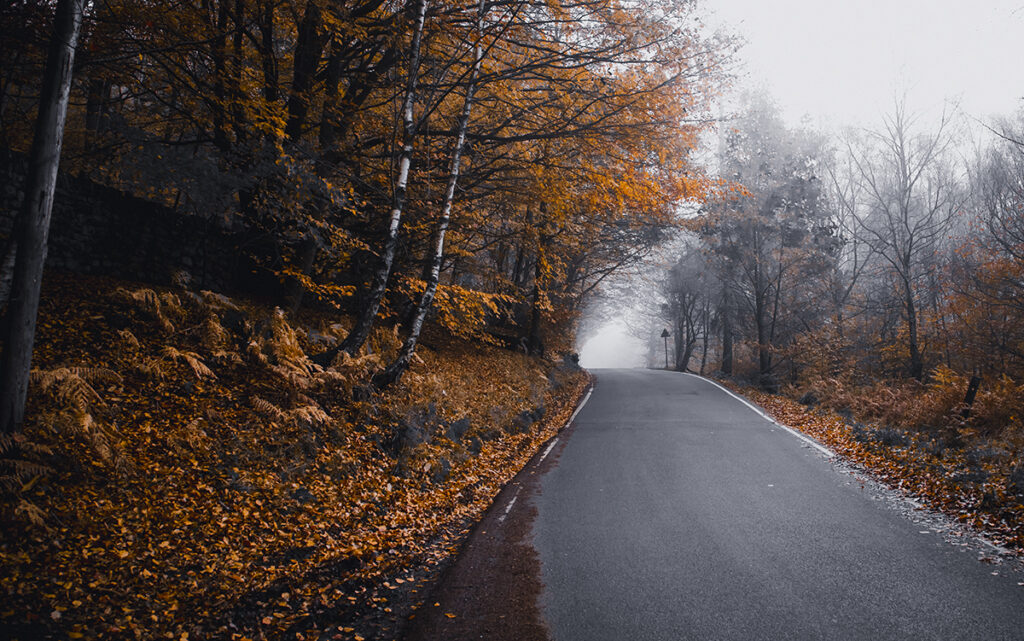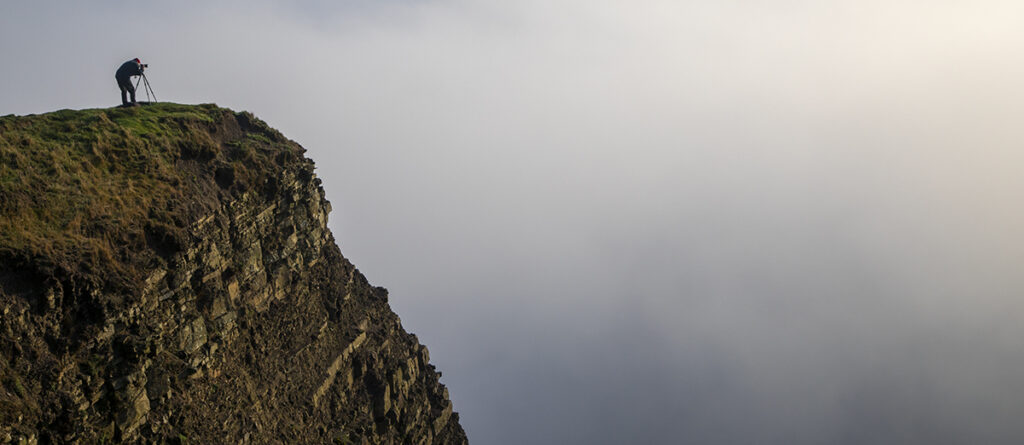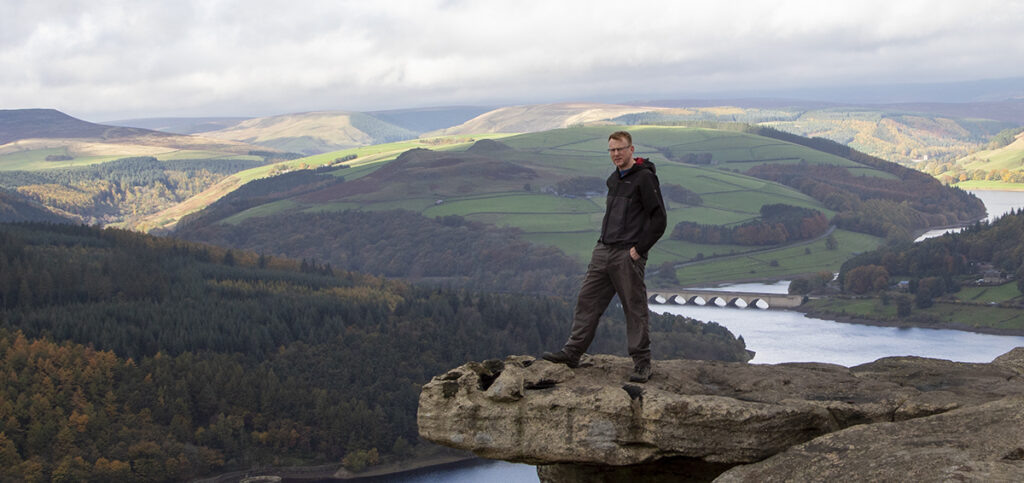Ultimate Peak District Landscape Photography Guide
As a landscape photographer in the Peak District, I’ve discovered that this breathtaking national park offers an endless canvas of photographic opportunities throughout the seasons. From iconic locations to hidden gems, the diverse landscapes of the Peaks provide rich visual stories waiting to be captured through my lens. The unique juxtaposition of rugged gritstone edges against soft pastoral valleys, ancient woodlands beside limestone gorges, and weathered millstones amid purple heather creates a photographer’s paradise of contrasts and textures.

Ultimate Peak District Landscape Photography Guide: Mam Tor and Winnats Pass
My photographic journey often begins at Mam Tor, the “Shivering Mountain” that dominates the skyline near Castleton. Arriving well before dawn, I’ve found that patience rewards the early riser. The first light breaking over the Great Ridge creates dramatic shadows and highlights the undulating landscape stretching toward Back Tor and Lose Hill. During autumn and winter mornings, temperature inversions transform the Hope Valley below into a sea of mist, with Mam Tor standing proudly above the clouds like an island in a white ocean.
The experience of photographing from Mam Tor’s summit at sunrise remains one of the Peak District’s most rewarding experiences. On one particularly memorable January morning, I arrived to find the entire valley filled with cloud, leaving only the distant peaks of Kinder Scout and the upper sections of the Great Ridge visible above a perfect temperature inversion. As the sun rose, it painted the sea of cloud with delicate pinks and oranges while casting long shadows from the ridge across this ethereal landscape. Such conditions can’t be guaranteed, but when they occur, they produce images of otherworldly beauty.
Just a short distance from Mam Tor, Winnats Pass offers equally compelling compositions. This limestone gorge, whose name derives from “Windy Gates,” channels both wind and light in fascinating ways. The steep limestone walls create natural leading lines, guiding the eye through this dramatic passage. I’ve spent countless mornings here watching as the rising sun gradually illuminates the gorge walls. On misty mornings, when shafts of light pierce through the fog, the pass takes on an almost mythical quality that translates beautifully in photographs.
The winding road through Winnats Pass provides a perfect compositional element, especially when photographed from the higher vantage points on either side of the gorge. In winter, when early morning sun strikes the eastern wall while leaving the western side in shadow, the contrast creates a dramatic three-dimensional effect that emphasizes the pass’s depth and scale. After rainfall, the limestone glows with enhanced color and texture, offering yet another variation on this iconic scene.

Beyond the Obvious: Hidden Photographic Treasures
While these iconic locations deservedly attract attention, I’ve found immense satisfaction in exploring the lesser-known areas of the Peak District. This exploration has led me to Chrome Hill and Parkhouse Hill in the Upper Dove Valley, which present distinctive profiles that photographers affectionately call the “Dragon’s Back.” These formations offer striking silhouettes against dawn skies, especially when low-lying mist weaves between them, creating ethereal scenes that reward those willing to venture off the beaten path.
The approach to Chrome Hill involves a modest hike that deters many casual visitors, meaning photographers often have this spectacular location to themselves, especially at dawn. The view from the summit provides a 360-degree panorama of the surrounding landscape, with Parkhouse Hill creating a perfect complementary element in many compositions. During the golden hours, the distinctive limestone outcrops catch the light beautifully, creating natural highlights against the softer valleys below.
For more intimate landscape compositions, Padley Gorge has become my sanctuary throughout the changing seasons. This ancient woodland, with its moss-covered rocks and twisted trees, provides year-round opportunities for capturing nature’s smaller details. In autumn, when the beech trees turn golden, the dappled light creates magical scenes as it filters through the canopy onto the tumbling stream below. These quieter locations often yield the most satisfying images in my portfolio.
Padley Gorge rewards photographers who take time to explore its full length. The upper sections near Grindleford offer cascades and pools surrounded by characterful birch and oak trees, while the lower gorge provides more enclosed, atmospheric compositions where the stream disappears between moss-covered boulders. After rainfall, the water level rises considerably, transforming gentle cascades into dramatic torrents that can be captured with slower shutter speeds to create silky water effects against the constant elements of rock and wood.
Another favorite spot in my photographic journey is Three Shires Head, marking the boundary where Derbyshire, Cheshire, and Staffordshire meet. Its series of small waterfalls and historic packhorse bridge work beautifully in soft, diffused light, making it perfect for overcast days when other locations might seem flat and uninspiring. This versatility has taught me that the Peak District offers photographic potential in virtually any weather condition, if you know where to look.
The remoteness of Three Shires Head adds to its charm. Accessible only by foot along ancient packhorse routes, the effort required to reach it (especially with camera equipment) ensures that it rarely feels crowded. The 18th-century bridge creates a perfect focal point, while the series of falls and pools below offer numerous compositional possibilities. In winter, when partially frozen, these waterfalls take on sculptural qualities that contrast beautifully with the weathered stonework of the bridge.
Eastern Edges: Stanage and Curbar
The eastern side of the Peak District offers a completely different landscape character dominated by the dramatic gritstone edges that have become synonymous with the Dark Peak. Stanage Edge, stretching for nearly four miles, presents an imposing natural rampart above the Derwent Valley. For photographers, the weathered gritstone set against expansive views creates compositions of remarkable scale and drama.
Dawn at Stanage often brings spectacular light as the sun rises over the distant eastern horizons, illuminating the face of the edge while moorland stretches away into the distance. The abandoned millstones that lie scattered below Stanage provide perfect foreground interest, their circular forms contrasting with the angular geometry of the rock face above. In late summer, when the heather blooms, patches of purple create additional color interest against the browns and greens of the moorland.
Further south, Curbar Edge offers similar drama with distinctive rock formations that create natural framing elements. The view west toward Chatsworth House and the Derwent Valley is particularly striking in evening light, when the setting sun bathes the landscape in warm tones. After rainfall, shallow pools form on the gritstone plateau, creating opportunities for reflection shots that add depth and interest to compositions of this ancient landscape.

Planning and Preparation: The Key to Successful Images
My approach to photographing these diverse landscapes has been transformed by the comprehensive guide “Photographing the Peak District” by Chris Gilbert and Mick Ryan (fotovue.com). This resource has become indispensable for my location planning, offering detailed maps, seasonal recommendations, and practical information about access and parking that has saved me countless hours of trial and error.
The book divides the Peak District into logical geographical sections, providing GPS coordinates for specific viewpoints alongside suggested compositions and optimal times of day. Each location entry includes information about walking distance, elevation gain, and technical challenges, allowing photographers to plan their expeditions with confidence. The inclusion of alternative viewpoints for popular locations has been particularly valuable during busier periods.
Speaking of parking, I’ve learned through experience that it can be particularly challenging at popular locations like Mam Tor, especially during weekends and holiday periods. For my sunrise shoots, I typically arrive 90 minutes before first light to secure parking and walk to my chosen composition point. The fotovue guide has proven invaluable for identifying alternative parking options and less crowded vantage points that still offer spectacular views.
With parking secured, efficient route planning allows me to capture multiple locations as the light changes throughout the day. A typical morning might begin with sunrise at Mam Tor, followed by golden hour light streaming through Winnats Pass, then exploring the broken road at Mam Tor’s base as the day progresses. Understanding how these locations relate to each other geographically has allowed me to maximize photographic opportunities in changing conditions, often visiting three or four sites in a single productive morning.
This geographical knowledge has proven particularly valuable when weather conditions change rapidly. On numerous occasions, I’ve been able to pivot quickly between locations, perhaps abandoning a planned dawn shoot at a high-elevation site when low cloud moves in, and instead relocating to a woodland location where misty conditions enhance rather than obscure the subject. The fotovue guide’s detailed mapping makes these spontaneous decisions both possible and productive.
Seasonal Transformations
Throughout my years photographing the Peak District, I’ve witnessed how each season brings its own distinct photographic possibilities to these landscapes. Spring breathes new life into the region, carpeting woodland floors with bluebells in locations like Padley Gorge and creating vibrant contrasts with the fresh green foliage against gray limestone outcrops.
The bluebell displays in the White Peak woodlands around Middleton-by-Youlgrave and Lathkill Dale create spectacular foreground interest in late April and early May. These ephemeral displays last only a few weeks but transform familiar landscapes with their intense color. The combination of fresh beech leaves allowing dappled light through the canopy and the blue carpet below creates a magical atmosphere that captures the essence of the English spring.
As spring transitions to summer, the longer days mean earlier starts but also dramatic weather conditions. Some of my most dynamic images have captured summer thunderstorms creating spectacular backdrops for landmarks like Chrome Hill, when dark skies and dramatic light transform familiar scenes into something extraordinary.
The summer months also bring the heather blooming across the high moorlands of the Dark Peak. Locations like Higger Tor and Over Owler Tor become transformed by swathes of purple extending to the horizon. This relatively brief flowering period (typically late July into August) coincides with longer, warmer evenings that are perfect for extended photography sessions capturing the last light as it rakes across the textured moorland.
Autumn remains my favorite season for Peak District photography, as the beech woodlands erupt in gold and crimson. The quality of light during this season seems especially rich, bringing depth and dimension to the landscape. Locations like Padley Gorge and Lumsdale Falls near Matlock reach their photographic peak during October and early November when fallen leaves add color to streams and pathways while the canopy above glows with warm tones.
Winter, however, offers its own rewards when snow simplifies compositions on the higher peaks, creating minimalist scenes of extraordinary beauty. The low winter sun also extends the golden hours, providing more time to work with that magical directional light that landscape photographers crave. After fresh snowfall, locations like Higger Tor and Mam Tor offer stark, graphic compositions where dark gritstone stands in perfect contrast to pristine white snow, creating almost monochromatic images of striking simplicity.
Technical Considerations in Challenging Terrain
Moving through these varied landscapes in unpredictable weather has taught me valuable lessons about technique and equipment. My wide-angle lenses capture the sweeping panoramas from high vantage points like Mam Tor, while medium telephotos compress distant layers of hills and isolate interesting features across valleys—particularly useful when shooting from the Great Ridge toward the Hope Valley.
The 16-35mm range proves invaluable for the dramatic limestone formations in locations like Winnats Pass and Gordale Scar, where the wide perspective captures both towering cliffs and interesting foreground detail. For the eastern edges like Stanage and Curbar, I often reach for a 24-70mm lens that allows me to isolate the most interesting rock formations while still including enough context to convey scale and location.
In my camera bag, graduated neutral density filters have become essential tools to help balance the often significant difference between bright Peak District skies and darker foregrounds. The rapid weather changes mean I frequently use these filters to retain cloud detail while maintaining shadow information in the landscape below. A polarizing filter also proves valuable, particularly in woodland settings where it reduces reflections on wet vegetation and enhances the richness of autumn colors.
Equally important is my sturdy tripod, which provides stability not only for low-light shooting but also in the frequently windy conditions that can challenge even the most experienced photographers on exposed ridges. The Peak District’s notorious winds, particularly on the eastern edges, have taught me to weigh down my tripod with my backpack and to use my body as a shield when necessary to prevent vibration during critical exposures.
Weather protection has become second nature after being caught in sudden downpours while photographing distant ridgelines. Both my camera equipment and personal gear now include reliable weatherproofing, as I’ve learned that conditions can change rapidly in this upland environment, sometimes delivering four seasons in a single day. Quick-deploy rain covers for cameras and lenses, alongside good-quality waterproof clothing, mean I can continue shooting when changing light creates dramatic opportunities during passing storms.

The Photographer’s Connection
Beyond these technical skills and equipment considerations, I’ve discovered that successful landscape photography in the Peak District emerges from developing a genuine connection with the land. My regular visits throughout the seasons, in all weather conditions, have built an understanding of how light interacts with specific locations—knowledge that proves more valuable than any camera technology. This intimate familiarity determines the difference between merely recording a scene and creating a compelling image that conveys the essence of a place.
This connection extends beyond photography to an appreciation of the Peak District’s rich cultural and industrial heritage. Understanding how the landscape has been shaped by centuries of human activity—from the prehistoric stone circles of Arbor Low to the industrial millstone quarries at Stanage—adds layers of meaning to photographs that might otherwise capture only surface beauty. The remains of lead mining around Castleton, the ancient field patterns of the White Peak, and the weathered gritstone barns of the Dark Peak all tell stories that can enrich landscape compositions.
The fotovue guide “Photographing the Peak District” has been instrumental in developing this connection, providing the local knowledge needed to be in the right place at the right time. With its guidance, I’ve found my own favorite spots and developed a deeper appreciation for this remarkable landscape. The book’s historical and geological context for each location has proven as valuable as its photographic advice, helping me understand the processes and human activities that have shaped what I see through my viewfinder.
Whether I’m capturing the grand vista from Mam Tor at dawn, the serpentine curves of Winnats Pass in morning light, or an intimate detail of moss-covered rocks in Padley Gorge, the Peak District continues to inspire and challenge me as a landscape photographer. It rewards those willing to rise early, stay late, and embrace its ever-changing moods—a relationship with the landscape that deepens with every visit and every frame.
This ever-evolving relationship with the Peak District landscape has taught me perhaps the most valuable photographic lesson of all: that knowledge of place, patience with conditions, and connection with the land matter more than the latest camera technology or photographic trends. The most compelling images emerge not from technical perfection alone, but from moments when light, landscape, and photographer come together in perfect harmony—moments that the Peak District, in all its diverse beauty, offers in abundance to those willing to seek them out.
